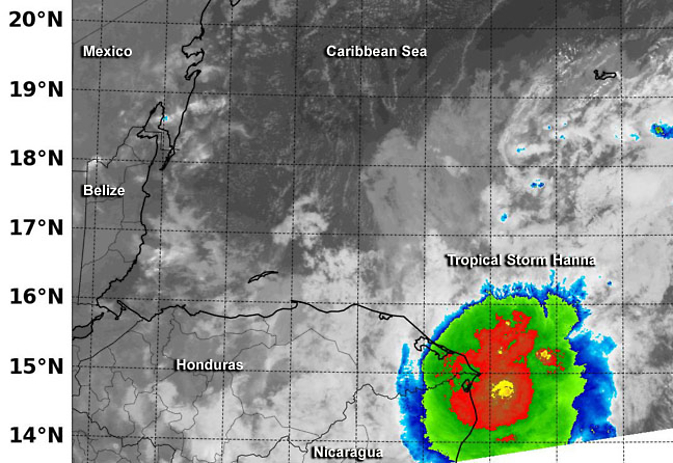NASA Sees a "Zombie" Tropical Storm Kick Off Halloween Week

NASA's Terra satellite passed over Tropical Storm Hanna on Oct. 26 at 11:45 p.m. EDT and saw high thunderstorms (red) around the newly reformed center of circulation with cold cloud top temperatures near -63F/-53C that indicated they were high in the troposphere. Image Credit: NASA/NRL
Tropical Depression 9 made landfall in Mexico's Yucatan Peninsula late last week and lingered as a remnant low pressure area on Saturday and Sunday, Oct. 25 and 26. Satellite data revealed that those remnants had reformed quickly and jumped up to tropical storm status, where it became “zombie” storm named Tropical Storm Hanna off the coast of Nicaragua. NASA's Terra satellite spotted strong thunderstorms around the zombie storm's center as it passed overhead.
At 9:30 a.m. EDT on Oct. 27, the National Hurricane Center (NHC) issued a tropical storm warning for Punta Patuca, Honduras southward to Puerto Cabezas, Nicaragua. A tropical storm warning means that tropical storm conditions are expected somewhere within the warning area…in this case within the next 6 to 12 hours.
The National Hurricane Center noted that tropical storm conditions are expected within the warning area through this evening. In addition, Hanna could produce 10 to 12 inches (250 to 300 mm) of rain, with isolated maximum amounts of 15 inches (400 mm), across Honduras and northern Nicaragua. These rainfall Amounts will produce life-threatening flash floods and mudslides.
NASA's Terra satellite passed over Tropical Storm Hanna on Oct. 27 at 03:45 UTC (Oct. 26 at 11:45 p.m. EDT) and the Moderate Resolution Imaging Spectroradiometer or MODIS instrument gathered infrared data on the storm.
The MODIS instrument showed high thunderstorms around the newly reformed center of circulation with cold cloud top temperatures near -63F/-53C that indicated they were high in the troposphere. Those strong thunderstorms have the potential to drop heavy rainfall.
Forecaster Berg at NHC noted that Hanna's center is very close to the coast of northeastern Nicaragua and moving to the west-southwest. Hanna is expected to make landfall and move inland over Nicaragua by late today, Oct. 27.
At 10 a.m. EDT, Hanna's center was near 14.5 north latitude and 83.2 west longitude. That's about 35 miles (60 km) north-northeast of Puerto Cabezas, Nicaragua, and about 35 miles (55 km) south of Cabo Gracias a Dios on the Nicaragua/Honduras border.
Hanna was moving toward the west-southwest near 7 mph (11 kph) and is expected to continue in that direction for the next day or two. Maximum sustained winds were near 40 mph (65 kph) and little change in strength is expected before landfall, followed by weakening as it moves inland.
Rob Gutro
NASA's Goddard Space Flight Center
Media Contact
All latest news from the category: Earth Sciences
Earth Sciences (also referred to as Geosciences), which deals with basic issues surrounding our planet, plays a vital role in the area of energy and raw materials supply.
Earth Sciences comprises subjects such as geology, geography, geological informatics, paleontology, mineralogy, petrography, crystallography, geophysics, geodesy, glaciology, cartography, photogrammetry, meteorology and seismology, early-warning systems, earthquake research and polar research.
Newest articles

NASA: Mystery of life’s handedness deepens
The mystery of why life uses molecules with specific orientations has deepened with a NASA-funded discovery that RNA — a key molecule thought to have potentially held the instructions for…

What are the effects of historic lithium mining on water quality?
Study reveals low levels of common contaminants but high levels of other elements in waters associated with an abandoned lithium mine. Lithium ore and mining waste from a historic lithium…

Quantum-inspired design boosts efficiency of heat-to-electricity conversion
Rice engineers take unconventional route to improving thermophotovoltaic systems. Researchers at Rice University have found a new way to improve a key element of thermophotovoltaic (TPV) systems, which convert heat…



